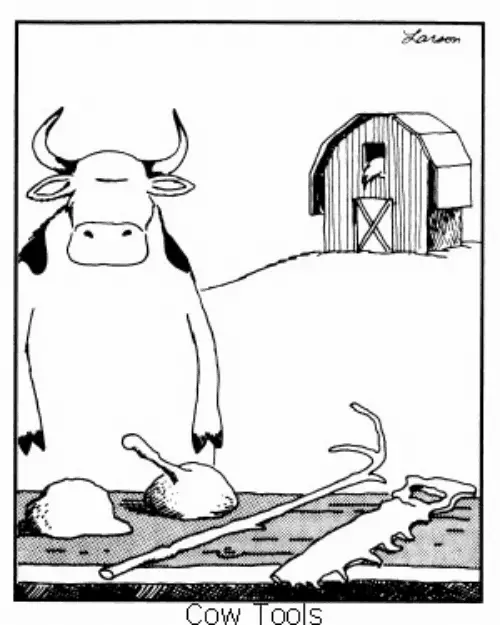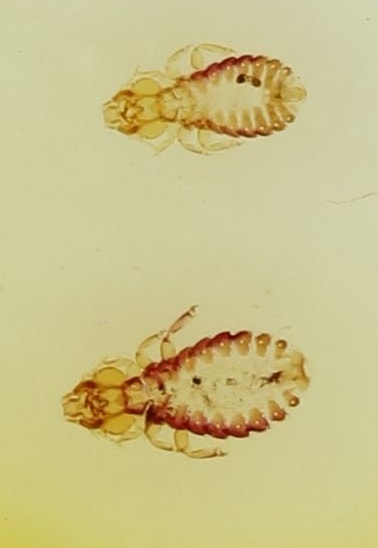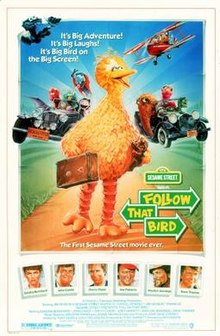
It was bizarre, irreverent, creative, sometimes offensive, and funny as hell. And for a kid like me growing up in the 80s, it was a comic strip right up my ally.
The Far Side was a comic strip that appeared from 1979 to 1995 created by Gary Larson. It is one of the most famous comic strips of all time and appeared in over 1900 different newspapers around the world. His books have sold over 45 million copies.
I can’t begin to explain what a profound effect The Far Side had on me as a kid. Like any great work, it felt like it was made just for you. I couldn’t believe there was a comic strip out there that appealed to my sensibility and sense of humor. With all due respect to some of the other great comic strips out there, The Far Side left them all in its dust.
The Far Side comic strip was a huge part of the 80s and would be the favorite comic strip of many people. There are many that would immediately check it out when they got their paper each day before reading anything else.
This is a look back on Gary Larson and the creation of his brilliant comic strip: The Far Side
Gary Larson Before The Far Side
Gary Larson was born in 1950 in Tacoma, Washington. His father was a car salesman and his mother a secretary. He grew up with a great fascination with animals while also developing a slightly dark sense of humor. He had a real fondness for animals and one of his main interests, he states, was to put two different kinds of insects in a jar “to see which one would devour the other.”
He studied communications in college but also had aspirations of being a biologist. But he was also a musician playing jazz guitar and banjo throughout high school and college. Among other things that influenced him growing up was a storybook called “Mr. Bear – Squash-You-All-Flat” which is about a bear that goes around a forest sitting on, and squashing, the houses of smaller animals.
Larson grew up with what he called a “morbid family” and was constantly tormented by his older brother, Dan. Dan would constantly fill him full of fear at the prospect of monsters living in their house and specifically under his bed and closest. This theme would often show up through the Far Side.
Larson admits to having been terrified of the dark and his greatest fear was being asked to go into the basement to get firewood for his father. Larson tells the story in an interview on ABC’s 20/20 with Lynn Sher that he would be halfway up the stairs when the lights would go out. It was his brother at the top who would turn them off and then hold the door closed shut while telling Gary, “do you hear it? Do you hear it breathing?”
Larson’s interest in animals and biology would continue throughout his childhood and his love of scientific knowledge was nurtured by his brother. They would often catch animals and reptiles and build their own terrariums in their basement. At this young age, Larson began to become protective of the environment knowing that mankind was not the ideal tenant for animals to share the earth with.
Setting The Stage For The Far Side Comic

Larson’s childhood fears, interest in science, love of animals, and a dark sense of humor would help shape what would become the Far Side comic – but he didn’t start out with it initially. As he went through his formative years he noticed how much the world was changing. As a kid growing up in the 50s, he was aware of how people had gone from “Leave it to Beaver” to thinking they needed bomb shelters.
Things like the Cuban Missile Crisis were occurring and there was the thought that the world may end any minute. While this was all going on, Larson was working in a music store but realized he hated it. Somehow, the idea of cartooning came into his head and he thought that he would give it a try.
He explains in his book “The Prehistory of Far Side” that he started with 6 cartoons and submitted them to a magazine called “Pacific Search” based in Seattle. This original strip was called “Nature’s Way” and appeared in 1976. He was paid $90 for the 6 strips and it encouraged him that this could be a good way to make some money.
He then started submitting cartoons to a newspaper called The Summer News-Review who were paying him $3 a cartoon. This took the wind out of his sails a bit as he obviously couldn’t live on that type of money. He ended up taking a job at a humane society to make ends meet but admits to running over a dog on the way to the interview.
He ironically would have the job as “cruelty investigator” at the Humane Society…
Taking The Next Step
In 1979, Larson befriended a reporter from the Seattle Times who helped get Nature’s Way published. The problem was Larson’s comics were a bit on the offensive side and his strip was placed next to the Junior Jumble. This started getting a lot of complaints leading to the Times canceling the strip in 1980.
Just before this, however, Larson began pitching his comic to other newspapers including the San Francisco Chronicle while he was on vacation there. The Chronicle bought the strip and wanted to use it for syndication. Larson admits to being so pumped after leaving the meeting that he imagined “Eye of the Tiger” playing in his head and was lucky to not have been hit by a car.
The San Francisco Chronicle had one issue and that was with the name “Nature’s Way” which they changed to The Far Side. Larson couldn’t care less what the name was and said in the Prehistory of The Far Side: “they could have called it ‘Revenge of the Zucchini People’ for all I cared.”
The Chronicle first debuted the Far Side on January 1, 1980, which worked out as the Seattle Times would drop “Nature’s Way” the next week.
What Makes The Far Side So Funny?
It’s hard to pinpoint it exactly, but it’s a combination of a few things. The first big one, I believe, is that with a single panel comic, the entire joke has to take place right in front of you. This allows for a more creative strip that makes you think and unfold the joke as you see it.
Compare this to a 3 or 4-panel comic strip. With this style of set up – like Charlie Brown for example – each panel is used to set up the joke and the final one results with the obvious cymbal crash/punchline. With the Far Side, the joke is revealed through the imagery and text.
The other thing is how he takes us into the life of animals but shows us how they exist the same as we do. They go about their day as if it’s no different to you and me, and it’s easy to buy into their reality.
It also points out the absurdity of the human condition and the structures and rules of society that we’ve put in place. Larson points out how we are really no different from the animals.
There’s also the absurdity of the look of the comic. The Far Side is not an artistic masterpiece and some of the drawings can be crude at times, but this lends itself well to the humor. Sometimes the drawings exist just as a placeholder to get the joke across – which is the ultimate intent of any comic strip.
The Far Side has a signature look with how people are portrayed including their single straight line to represent their eyes. Back when I thought I could draw I would always try to incorporate some of this look into my own comics and cartoons.
Larson’s Fear Of The Success Of The Far Side
When the Far Side was really taking off in the 80s, a lot of the success was catching Larson off guard. Larson was not on board with all the publicity that was surrounding him. Everyone wanted to know more about the man behind the strip and what really made him tick.
This was the double-edged sword of success: the strip was reaching a vast audience and bringing in Larson a lot of money, but it was starting to go in the opposite direction. The enormous success of the Far Side was now lending itself towards merchandising. If you remember in the 80s, Far Side merch was everywhere. The book was one thing but you now had:
- Greeting cards
- Coffee mugs
- Calendars
- T-shirts
Larson would share in that 20/20 interview that the only thing that really scared him was “the merchandising monster.” He was worried that the commercialism surrounding the Far Side would destroy the essence of the Far Side along with the “very special rapport” he had built with his audience. He didn’t want the people who were loyal to him and the comic to start thinking that the Far Side was becoming too mainstream.
This is always an issue with anything that gets successful whether it be bands or comic strips. How do you keep it growing but still keep it true to the original audience that helped get you there? Larson did draw the line at having Far Side plush dolls produced though…
The Far Side’s Contribution To Science

Gary Larson and the Far Side has a deep connection with all things science. Science is a major influence on the strip and many of the classic comics. He always shared his deep love of science that resonated with many others and would never dumb down anything.
He has famously parodied Jane Goodall and his strip always connected well with those in the science community. In his book “The Far Side Gallery 3” the forward was written by famous scientist and head of the Museum of Comparative Biology at Harvard: Steven Jay Gould.
Gould makes note how hallways of science labs and universities were now displaying Far Side cartoons on their bulletin boards. Gould figures that 80% of his colleague’s doors feature a Far Side cartoon on it. They consider Larson “the national humorist of natural history.”
The Far Side features jokes about:
- Zoology
- Embryology
- Evolution
- Astronomy
- Biology
- Anthropology
- Chemistry
And science has rewarded him back.
In March 1989, a new type of insect was discovered by Dale H. Clayton, head of the Committee of Evolutionary Biology at the University of Chicago. The insect was a type of louse that was commonly found on owls – and it was named after Larson.
The new species of insect was dubbed the Strigiphilus garylarsoni.
And it didn’t stop there. A new species of butterfly found in Ecuador was named after Larson as the Serratoterga larsoni. There is also a beetle called the Garylarsonus and part of Stegosaurus anatomy is now known as the “thagomizer” based on one of his cartoons.
The Future Of The Far Side
The last Far Side comic appeared on January 1, 1995, when Larson stepped away from it and seemingly retired. Larson felt the strip had run its course and it didn’t want to get into repetition. He also stepped away from any appearances or interviews and let the strip continue to run on.
But there had always been the issue with the Far Side and the internet: When Larson was getting set to retire, the internet was just in its infancy. No one was sure how this new innovation would impact society or what uses there may be for it.
The Far Side always existed as a physical medium through newspapers and books, but now there was this whole digital “online” world. The problem now was that anyone with a scanner could just copy Far Side cartoons and put them up anywhere without any consent from Larson.
Larson worked to thwart the unapproved spread of his work which was popping up on Far Side websites without his permission. He would send out takedown notices and ended up publishing an open letter online stating his personal work was now being taken control of by others and was now becoming impossible to manage.
The Far Side seemed destined for an official website but that never happened – until it did. Gary Larson finally gave the world what they wanted with the official Far Side website. The site takes back control of the comic and allows Larson to connect with his audience.
There’s a personal letter from Larson on the site explaining his decision to now take things digital along with information about the site. It also features Gary’s bio, a section devoted to his old sketchbook, and a different comic featured each day. There is a curated comic section and an online store where you can get all the classic books.
Wrapping It Up
So in case you hadn’t noticed, I love The Far Side. It not only spoke to my sensibilities but reassured me that I wasn’t the only one who had a certain sense of humor. Like you probably experienced, there are dozens of comics that made me physically hurt from laughing.
I’m pretty sure you can’t make that case for any other comic strip. As great as many of the classic comic strips are, they at best would maybe draw a slight chuckle from you. It was unique to find a comic strip that made you actually laugh out loud – thankfully before saying ‘lol’ became a real thing.
I would spend hours reading all the Far Side books I had and any money I could save up I would use to buy more while other kids were saving for video games or hockey cards. I think Stephen King summed it up best when he wrote the forward for “The Far Side Gallery 2”:
“You start smiling; then you’re grinning; then you start to giggle; then you start to laugh; then you begin to howl; finally you are lying on the floor hoping to God you won’t have a hernia or a heart attack, telling yourself to stop, for God’s sake stop looking at them, but you go along just the same because he’s drawn you into a unique Larsonian world where deer talk with oddly persuasive matter-of-factness; where Godzilla drive a Plymouth with a license plate reading 1 8 NY, one arm cocked out the window, smiling grimly; where a crazed flea marches through hairs the size of Sequoias holding up a sign which reads THE END OF THE DOG IS COMING! It’s all insane but you can’t stop.”



